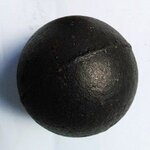Hi,
I found this at an estate sale. It's a perfectly spherical iron ball measuring ~2.9 inches in diameter and weighing 3lbs 5oz. It has patina and evidence of past pitting. From the dimensions it seems to match U.S. Army Ordnance specs for 3" grape shot, though there's only an average given for weight. Using their formulas it seems to be close to what it should be, given wartime quality control. The organizer thought it might be a milling ball, but admitted he didn't really know and didn't want to speculate. I picked it up because the manufacture seemed too clean to be an ore crusher (also it would be an extremely small example) and the composition seems to be the same as a few pieces of authenticated canister shot I have in my collection (similar patina, similar mottling, similar casting texture), and for $10 I was willing to gamble. If you all have any input I'd sure appreciate it.
Thanks,
Dubbs


I found this at an estate sale. It's a perfectly spherical iron ball measuring ~2.9 inches in diameter and weighing 3lbs 5oz. It has patina and evidence of past pitting. From the dimensions it seems to match U.S. Army Ordnance specs for 3" grape shot, though there's only an average given for weight. Using their formulas it seems to be close to what it should be, given wartime quality control. The organizer thought it might be a milling ball, but admitted he didn't really know and didn't want to speculate. I picked it up because the manufacture seemed too clean to be an ore crusher (also it would be an extremely small example) and the composition seems to be the same as a few pieces of authenticated canister shot I have in my collection (similar patina, similar mottling, similar casting texture), and for $10 I was willing to gamble. If you all have any input I'd sure appreciate it.
Thanks,
Dubbs


Amazon Forum Fav 👍
Last edited:





